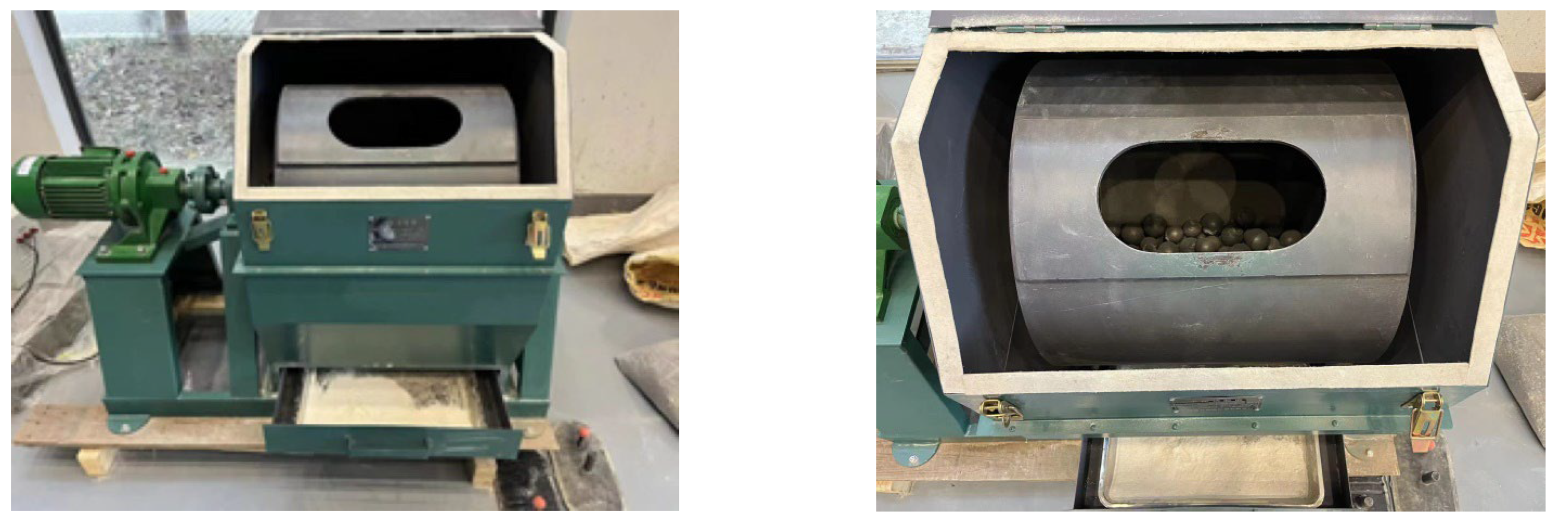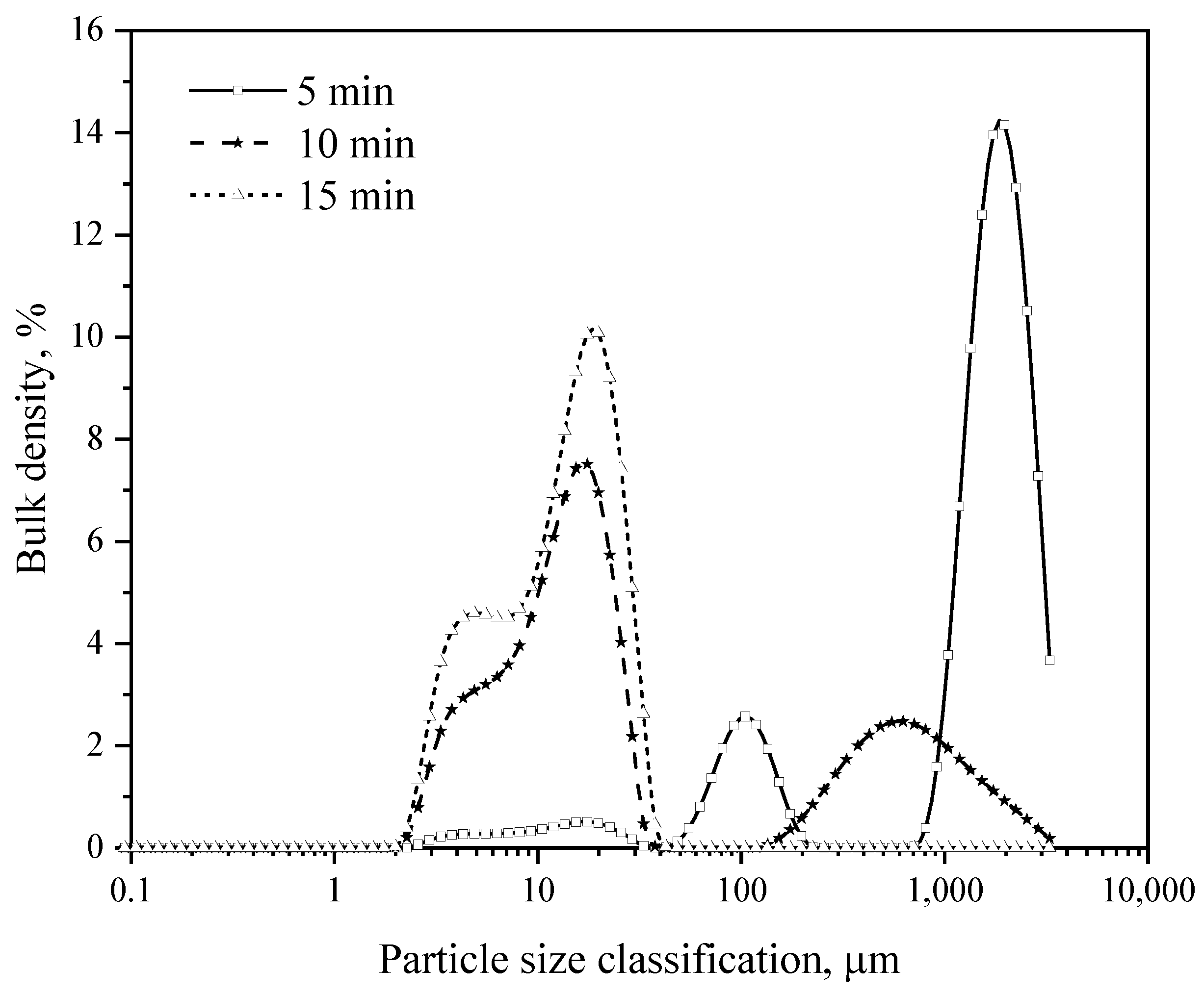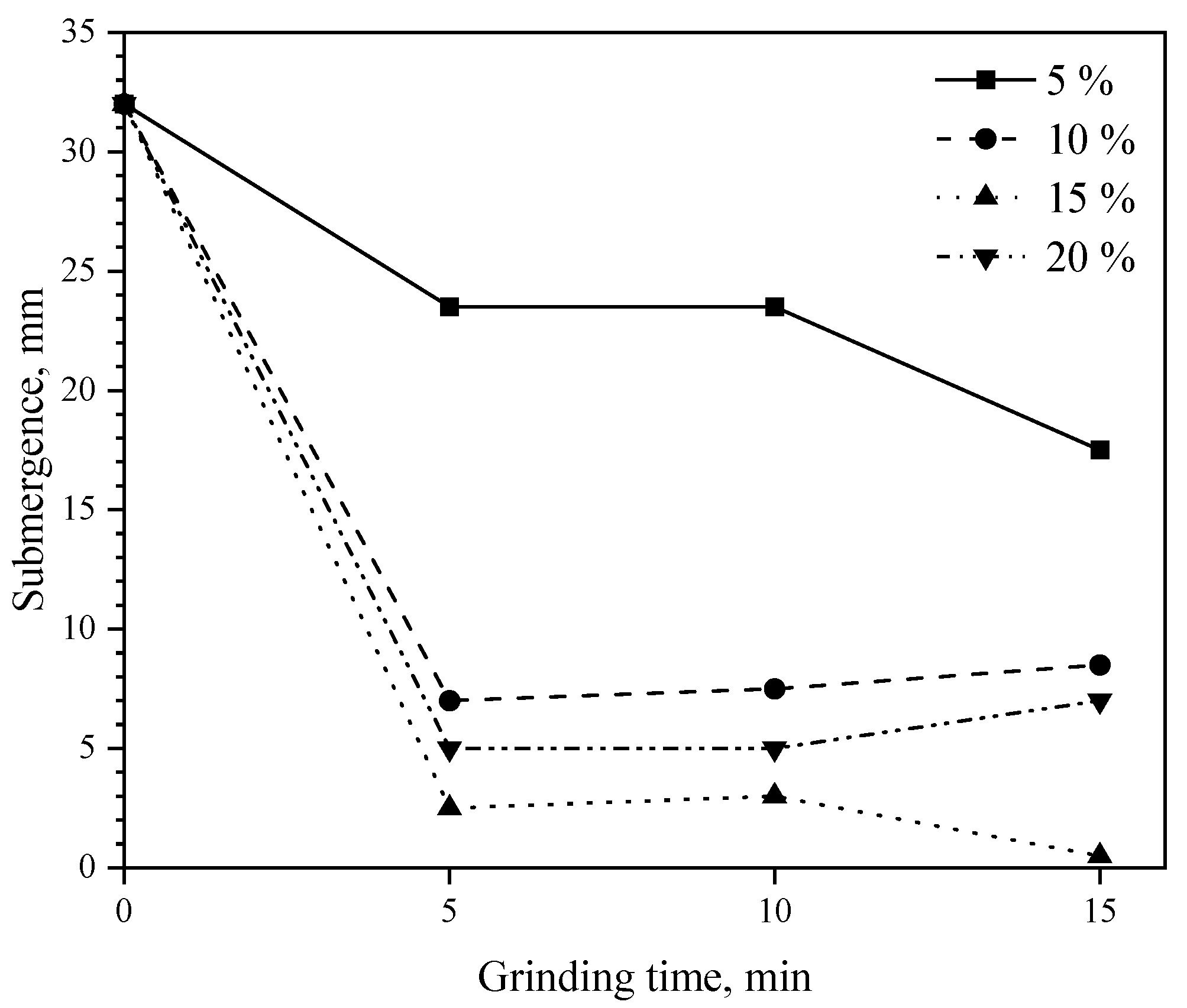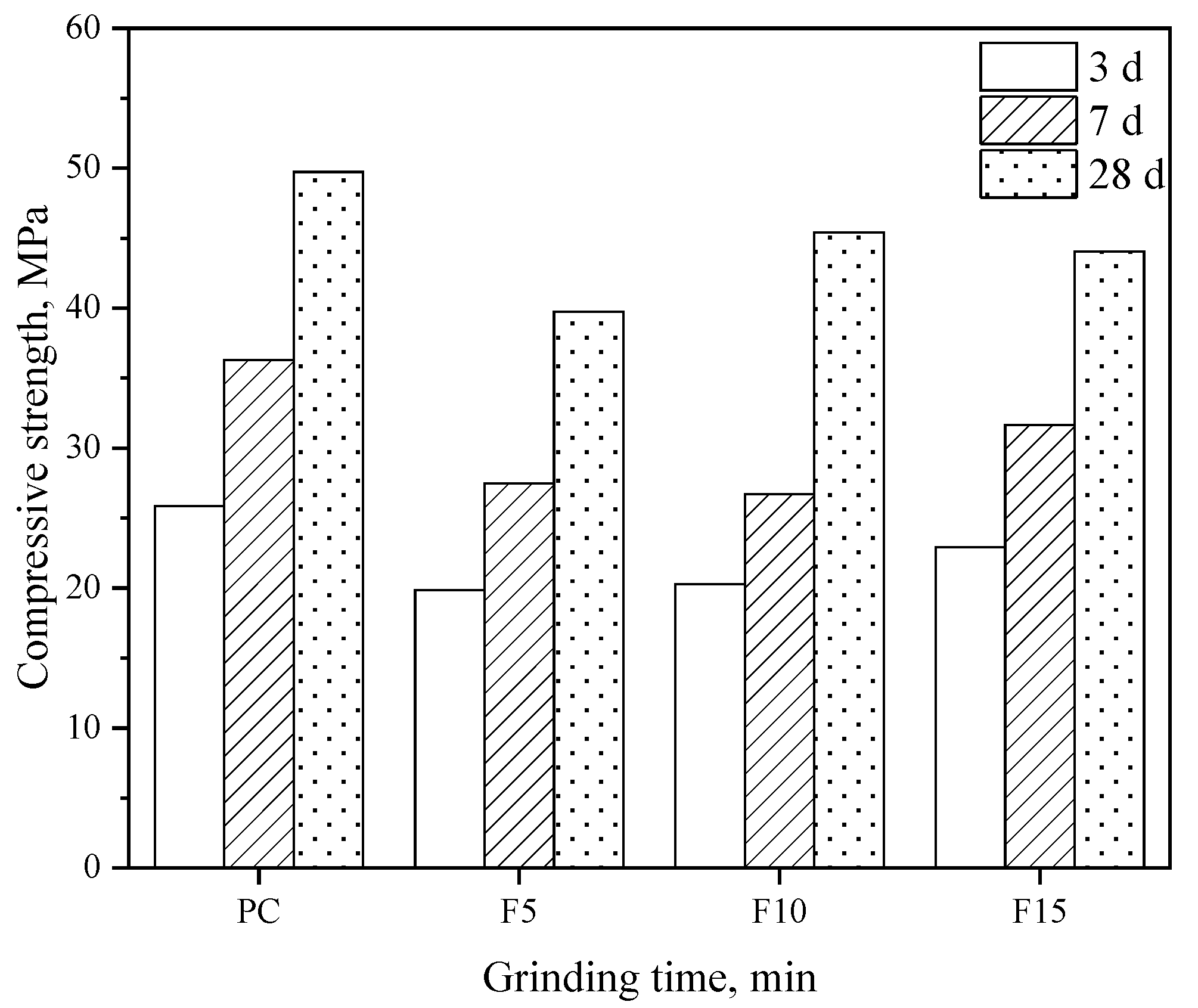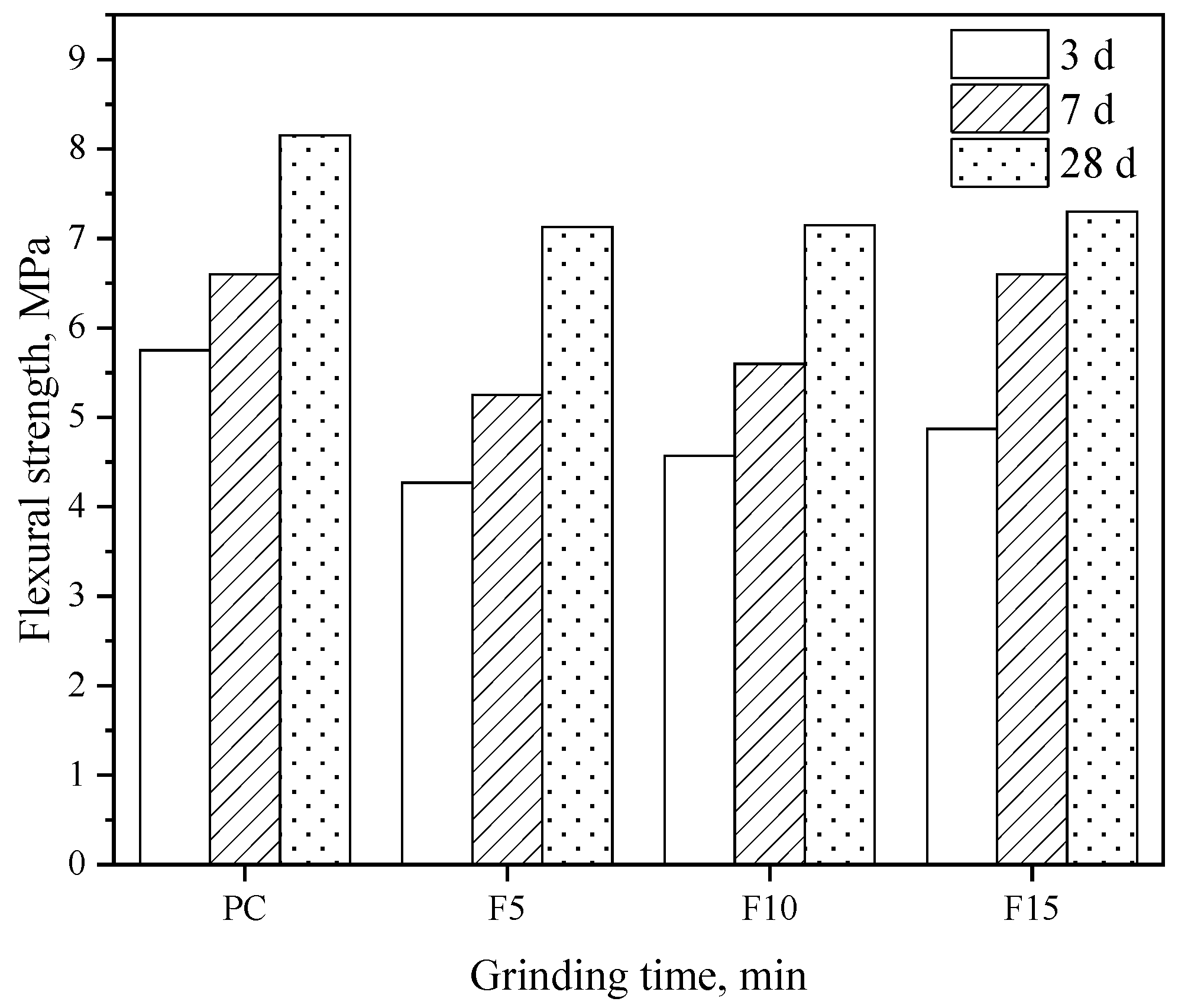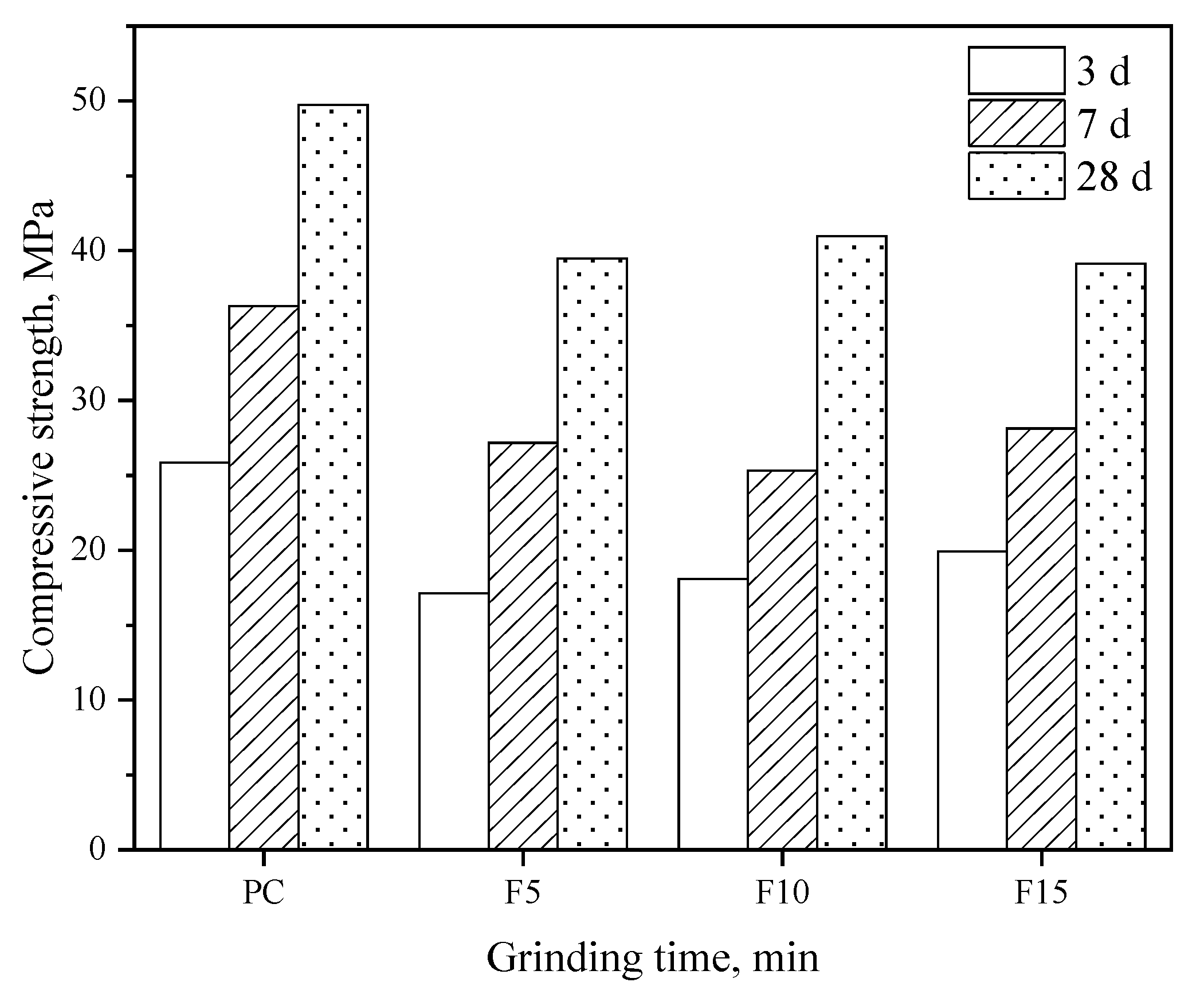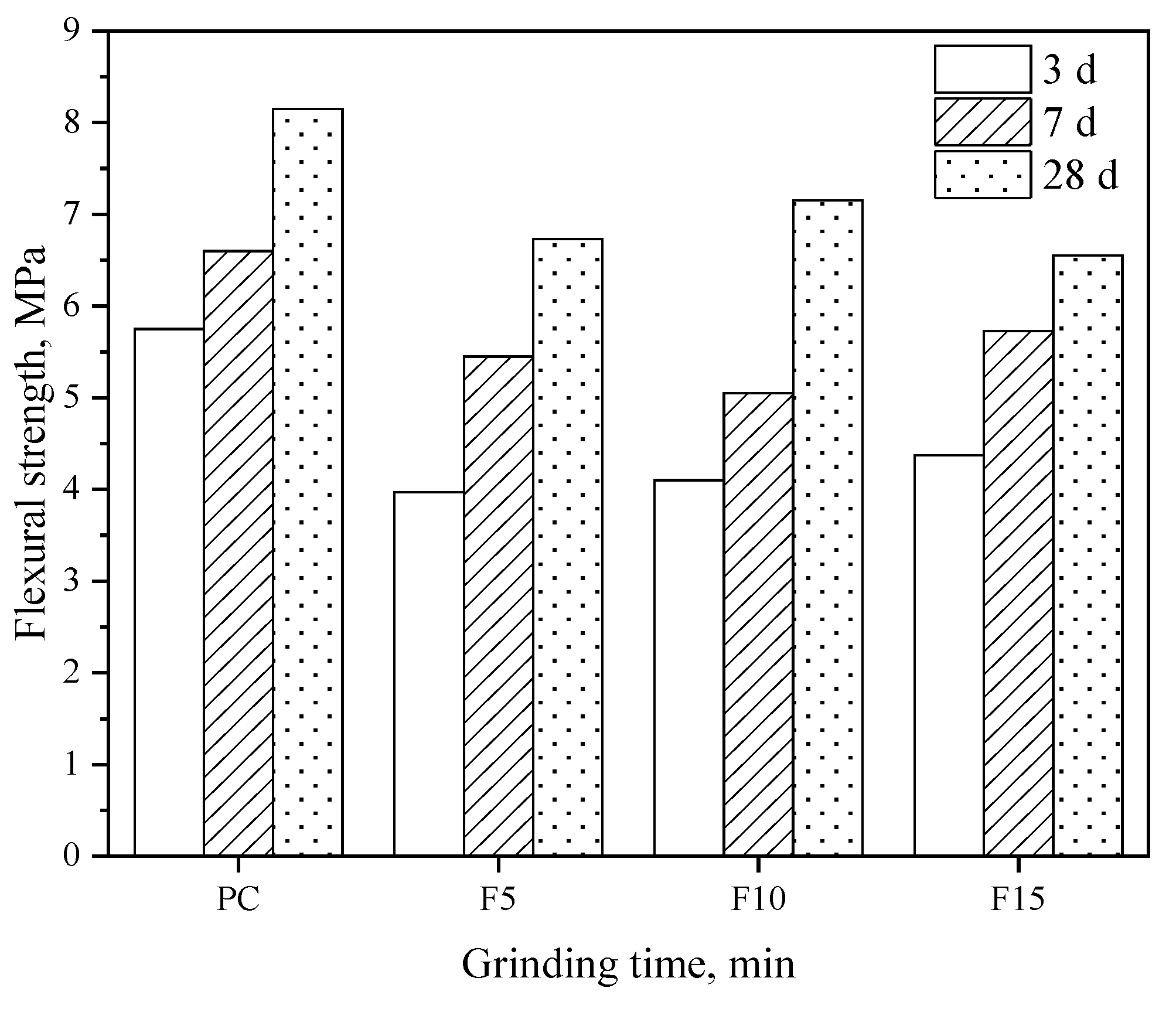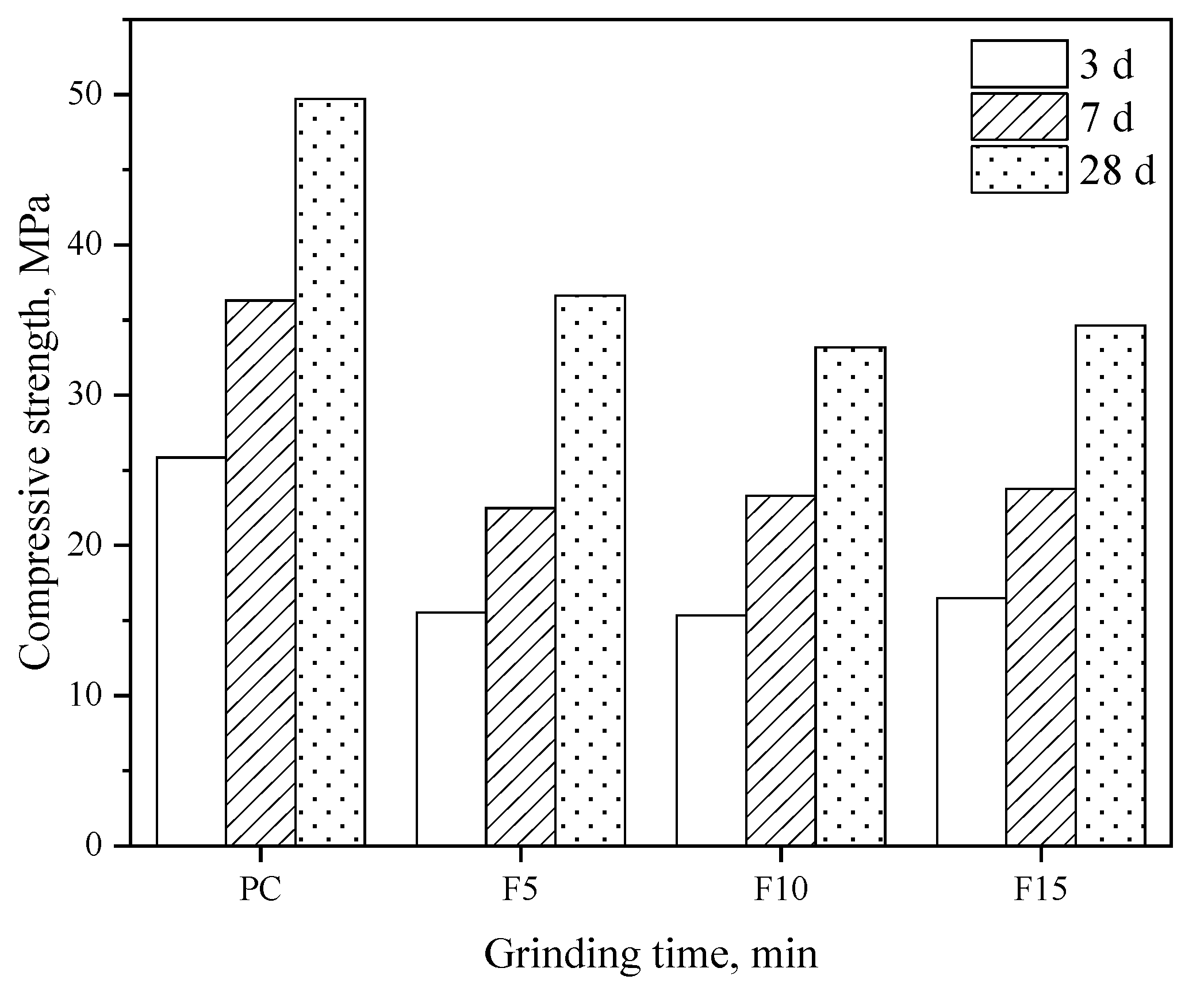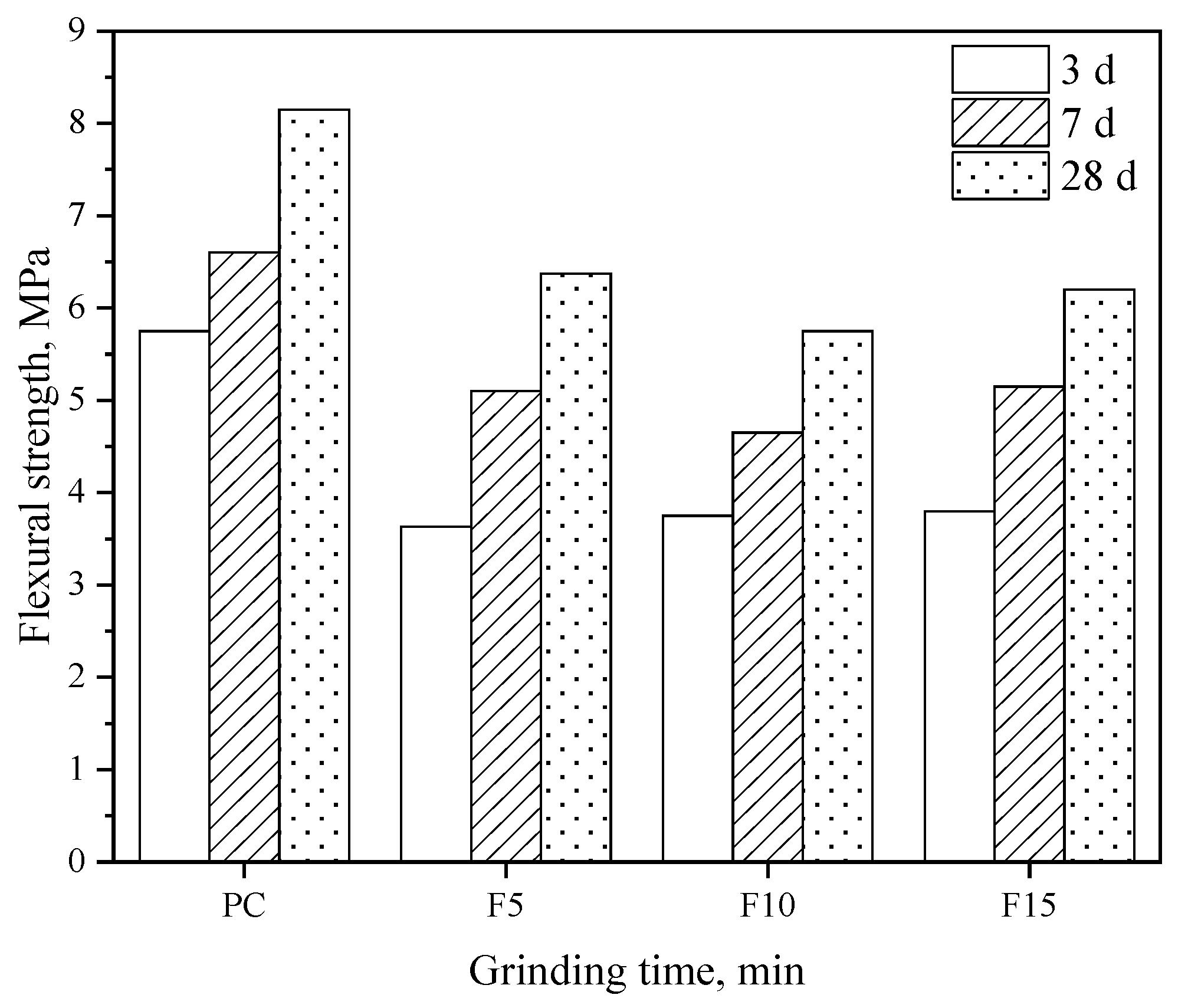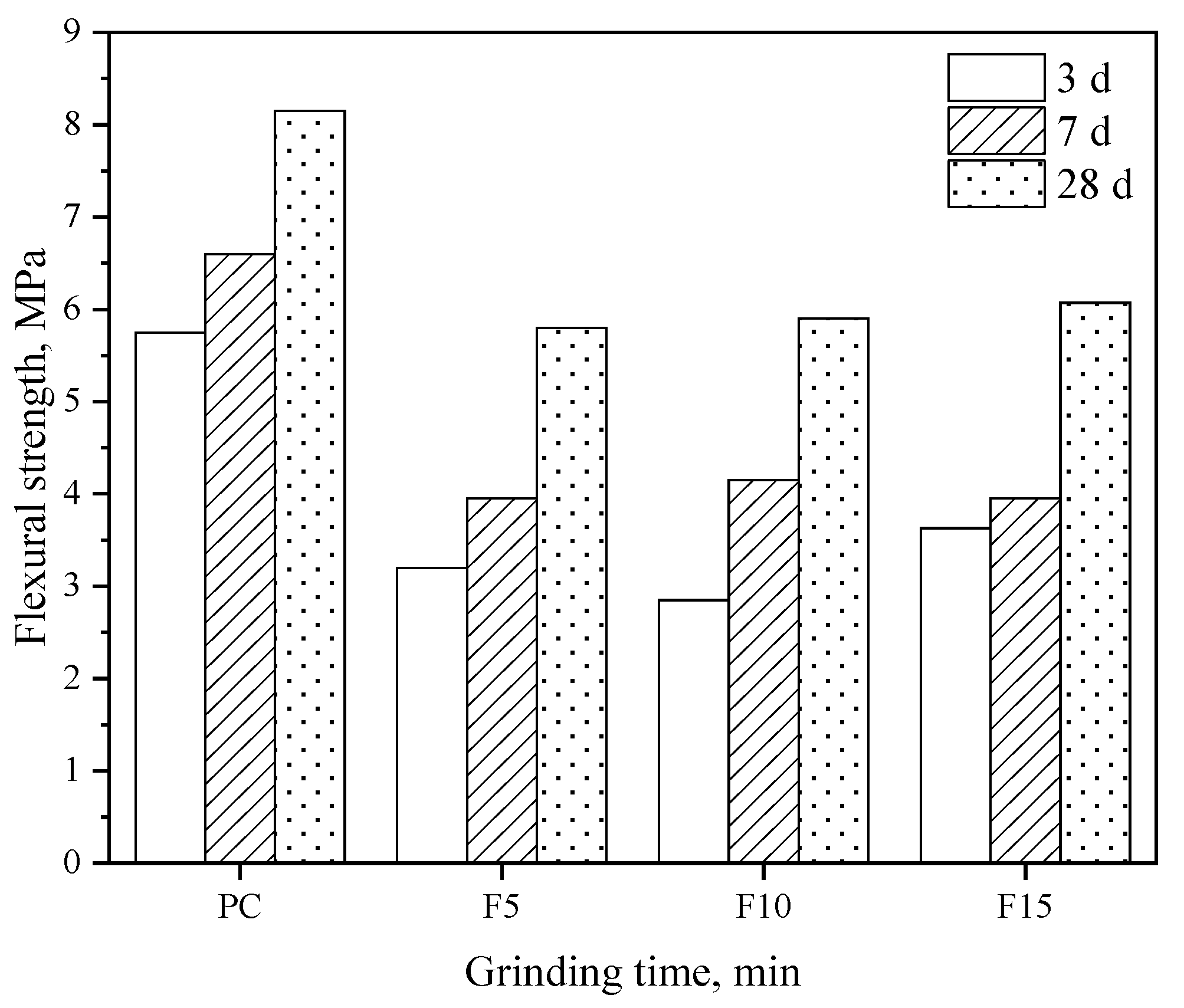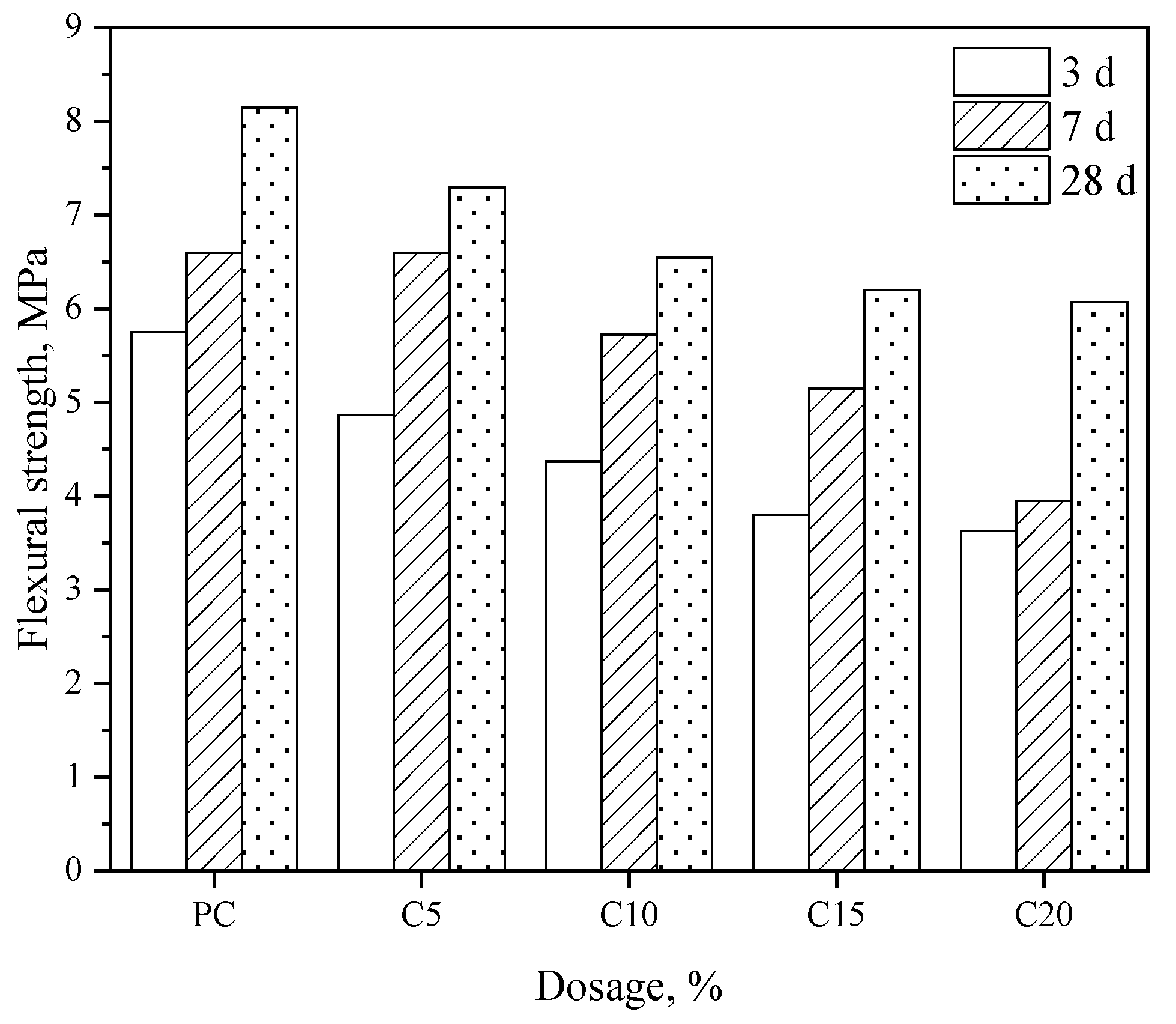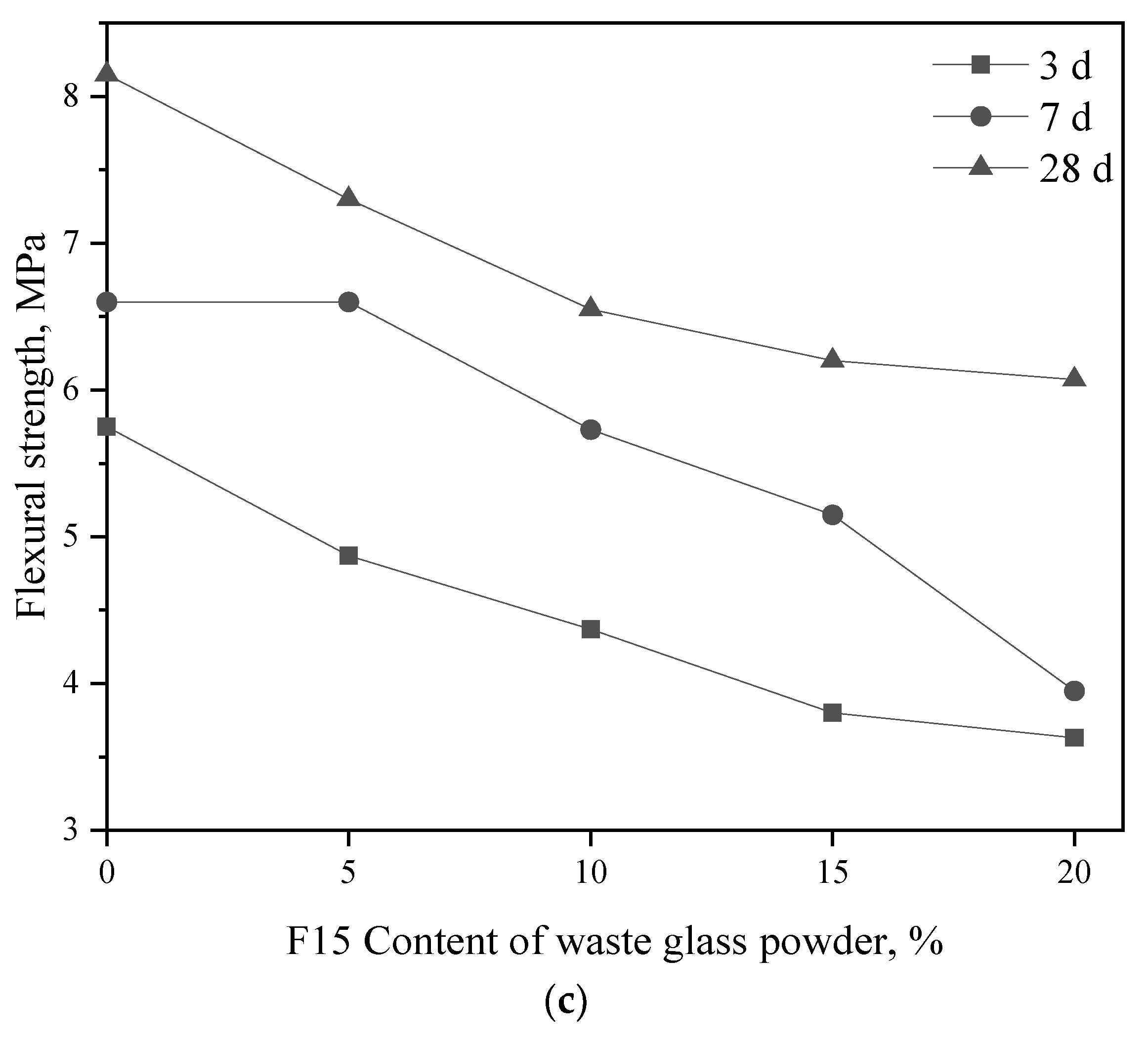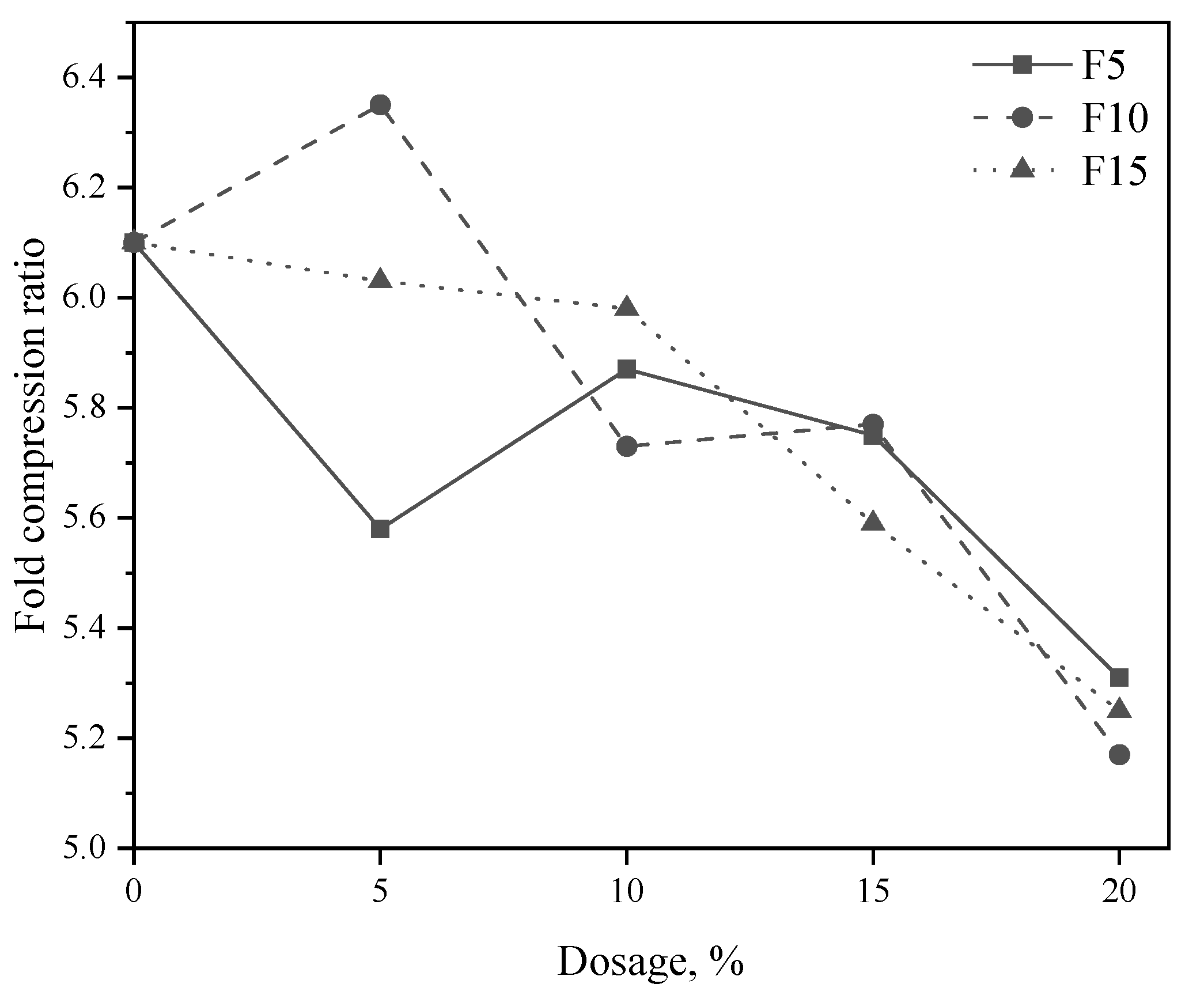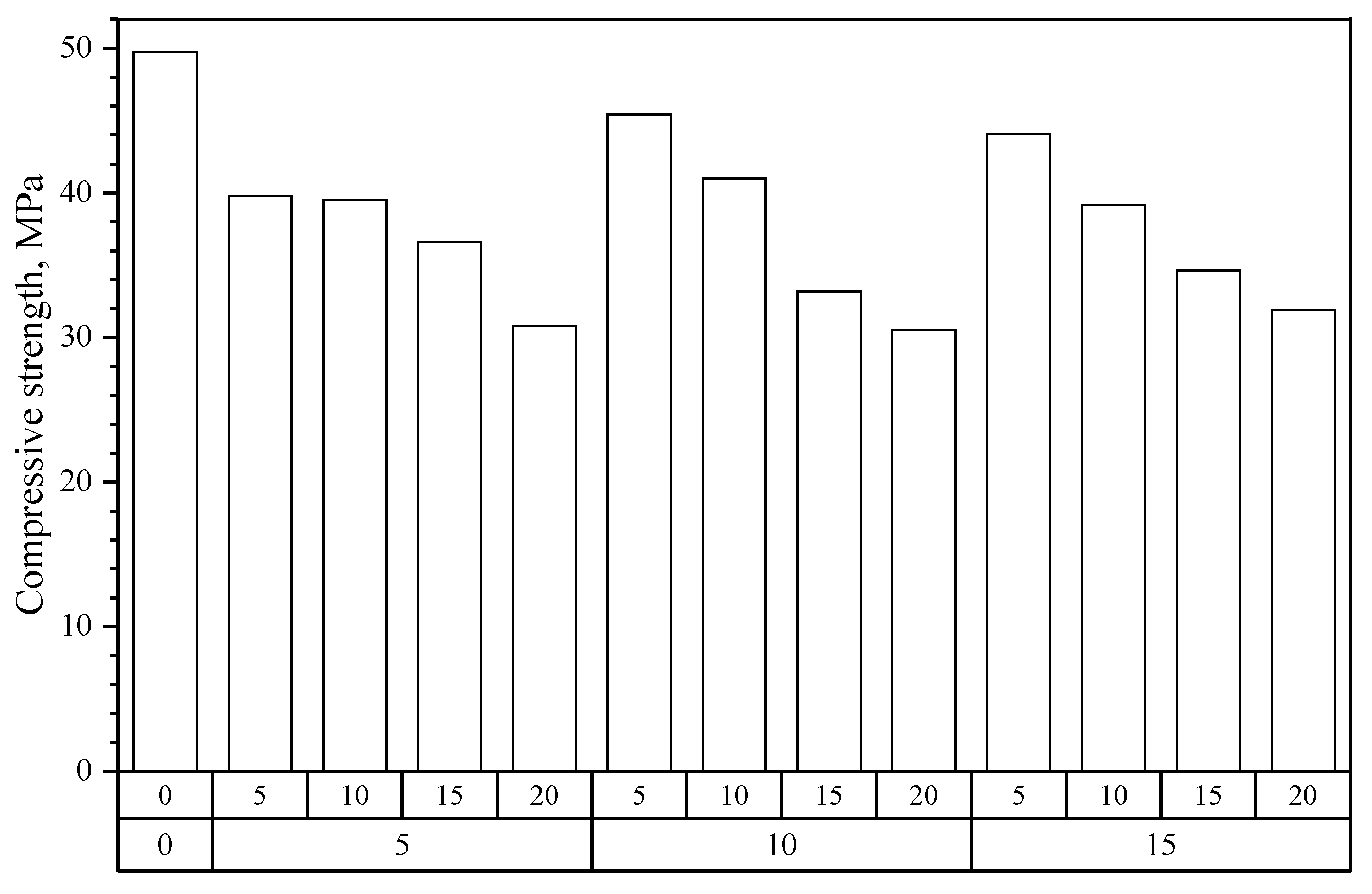3.1. Effect of Grinding Fineness on Mortar Consistency
The particle size distribution of WGP after grinding was characterized and tested by a Malvern laser particle size analyzer (Mastersizer 3000E). The particle size distribution curves of the WGP under different grinding times are shown in
Figure 3. It can be seen that there are still many large particles in the waste glass powder after grinding for 5 min to form the double peaks of the particle size grading curve. Increasing the grinding time to 10 min, the volume density of the double peaks gradually decreases. The double peak of the particle size grading curve shifted toward smaller particle sizes, and the particle size distribution of waste glass powder formed a single peak distribution after 15 min of grinding. The particle sizes of the waste glass powder after grinding for 5 min, 10 min, and 15 min were 91.2–2680 μm, 4.87–889 μm, and 4.01–25.6 μm, respectively.
Table 3 shows the specific surface area and average particle size of waste glass powder after grinding for 5 min, 10 min, and 15 min. It can be seen that the specific surface area of waste glass powder increased significantly after 15 min of grinding, and the average particle size reached 13.2 μm. This shows that the longer the grinding time, the better the grading of the waste glass powder. The increase in fineness leads to an increase in specific surface area, which helps waste glass powder participate in the reaction and improve the strength of waste glass powder cement mortar.
In the experiment, 500 g of P • O42.5 ordinary Portland cement and an appropriate amount of water were used to measure the consistency value (sinking amount) of 32 mm. The water consumption of the corresponding standard consistency was 142.5 g, the initial setting time was 180 min, and the final setting time was 270 min. On the premise of constant water consumption, waste glass powder with different grinding times and dosages was used to replace part of the cement to measure the consistency value of each group.
The influence of the consistency value of the cement mortar specimen with the grinding time of the waste glass powder at each dosage is shown in
Figure 4. As can be seen from
Figure 4, the consistency of cement mortar specimens, on the whole, decreases with the increase in grinding time. At 5%, with the increase in grinding time, the consistency of cement mortar remained unchanged and then decreased. Compared with the reference group, F5, F10, and F15 decreased by 26.6%, 26.6%, and 45.3%, respectively. At 10%, with the increase in grinding time, the consistency value of the cement mortar specimen is improved. At F5, the consistency value was the lowest, which decreased by 78.1% compared with the benchmark group. At 15%, the consistency value of the F15 cement mortar specimen decreased the most compared with the reference group, which was 98.4%. At 20%, F5, F10, and F15 decreased by 84.4%, 84.4%, and 78.1%, respectively, compared with the baseline group. It can be seen that the dosage has a great influence on the consistency of the cement mortar. This is because the specific surface area of waste glass powder is larger, and the greater the mixing amount, the greater the water demand. However, when the total water consumption is constant, the fluidity decreases and the consistency value decreases.
3.2. Effect of Grinding Time of Waste Glass Powder on Compressive and Flexural Strength of Mortar
Figure 5 shows the influence of different grinding times on the compressive strength of mortar specimens when the content of waste glass powder is 5%. Compared with the PC group, the compressive strength of F5, F10, and F15 decreased by 23.2%, 21.5%, and 11.3% at the age of 3 d, respectively. At 7 days, the compressive strength of F5, F10, and F15 decreased by 24.3%, 26.4%, and 12.8%, respectively, compared with that of the PC group. At 28 d, the compressive strength of F5, F10, and F15 decreased by 20.1%, 8.7%, and 11.4%, respectively, compared with that of the PC group.
With the increase in grinding time, the fineness of the waste glass powder decreases, and the strength of the waste glass powder mortar specimens increases gradually. Compared with 3 d compressive strength, the strength of the PC group increased by 40.4% and 92.4% at 7 d and 28 d, respectively. The strength of the F5 group increased by 38.4% and 100.3% at 7 d and 28 d, respectively. The strength of the F10 group increased by 31.8% and 123.9% at 7 d and 28 d, respectively. The strength of the F15 group increased by 38.1% and 92.2% at 7 d and 28 d, respectively. It can be found that the strength development of different grinding times in the early stage is lower than that of the PC group, and in the later stage, except the F15 group, which is slightly lower than that of the PC group, the rest are significantly higher than that of the PC group. It can be seen that the compressive strength of each group increases to different degrees with the increase in age, and the improvement of compressive strength in the late stage is significantly higher than that in the early stage, which is mainly because the secondary hydration of waste glass powder needs to be carried out under alkaline conditions, and the time lags behind the hydration of cement.
Figure 6 shows the effects of different grinding times and reference groups, 5% waste glass powder content, and different ages on flexural strength. Compared with the reference group, the influence of waste glass powder cement mortar specimens on flexural strength at each grinding time is similar to that of compressive strength. At the same age, the flexural strength of the waste glass powder increases continuously with the increase in grinding time.
The change in flexural strength of mixed mortar mixed with waste glass powder was significantly higher than that of the reference group. The longer the curing time, the better the development of strength. In the PC group, the flexural strength of 7 d and 28 d increased by 14.8% and 41.7%, respectively, compared with 3 d. However, in the F5 group, the flexural strength of 7 d and 28 d was increased by 23.0% and 67.0%, respectively, compared with that of 3 d. In the F10 group, the flexural strength of 7 d and 28 d was increased by 22.5% and 56.5%, respectively, compared with that of 3 d. In the F15 group, the flexural strength of 7 d and 28 d was improved by 35.5% and 49.9%, respectively, compared with that of 3 d.
Figure 7 shows the influence of different grinding times on the compressive strength of mortar specimens when the content of waste glass powder is 10%. It can be seen that, at the same age, the compressive strength of waste glass powder mortar specimens with different grinding times has decreased by varying degrees compared with the reference group. With the increase in grinding times, the compressive strength of waste glass powder mortar specimens tends to change smoothly at various ages. Compared with 3 d compressive strength, the strength of the PC group increased by 40.4% and 92.4% at 7 d and 28 d, respectively. The strength of the F5 group increased by 58.7% and 130.6% at 7 d and 28 d, respectively. The strength of the F10 group increased by 40.2% and 126.8% at 7 d and 28 d, respectively. The strength of the F15 group increased by 41.2% and 96.5% at 7 d and 28 d, respectively. Except for the F10 group being slightly lower than the PC group in the early stage, the compressive strength of the different grinding times at various ages was generally higher than the PC group. This indicates that secondary hydration is developed to a certain extent with increased waste glass powder content.
Figure 8 shows the influence of 10% waste glass powder content at different grinding times and reference groups on the flexure strength at different ages. Compared with the reference group, the effect of waste glass powder cement mortar specimens on flexural strength and compressive strength at each grinding time is similar. At the same age, the flexural strength of waste glass powder tends to stabilize with the increase in grinding times.
The flexural strength of mixed mortar mixed with waste glass powder changed significantly compared with the reference group. The longer the curing time, the better the development of strength. In the PC group, the flexural strength of 7 d and 28 d increased by 14.8% and 41.7% compared with 3 d, respectively. However, in the F5 group, the flexural strength of 7 d and 28 d increased by 37.3% and 69.5% compared with 3 d, respectively. In the F10 group, the flexural strength of 7 d and 28 d increased by 23.2% and 74.4% compared with 3 d, respectively. In the F15 group, the flexural strength of 7 d and 28 d increased by 31.1% and 49.9% compared with 3 d, respectively.
Figure 9 shows the influence of different grinding times on the compressive strength of mortar specimens when the content of waste glass powder is 15%. It can be seen that the compressive strength of waste glass powder mortar specimens with different grinding times is significantly lower than the reference group at various ages. At the age of 3 d, the compressive strength of F5, F10, and F15 decreased by 39.9%, 40.6%, and 36.2% compared with the PC group. At 7 d, the compressive strength of F5, F10, and F15 decreased by 38.1%, 35.8%, and 34.6% compared with the PC group. At 28 d, the compressive strength of F5, F10, and F15 decreased by 26.4%, 33.3%, and 30.4% compared with the PC group. It can be seen that under the 15% waste glass powder content, the compressive strength of mortar specimens under different grinding times is less than 70% of the PC group’s strength at each age. This shows that excessive waste glass powder will affect the further reaction with calcium hydroxide, decreasing the strength.
Figure 10 shows the influence of different grinding times on the flexural strength of mortar specimens when the content of waste glass powder is 15%. Compared with the reference group, the influence of waste glass powder cement mortar specimens on flexural strength and compressive strength at various grinding times is similar. The flexural strength of waste glass powder mixed at 15% at different grinding times is generally lower than the reference group.
Figure 11 shows the influence of different grinding times on the compressive strength of mortar specimens when the content of waste glass powder is 20%. At the same age, the compressive strength of mortar specimens with different grinding times of waste glass powder at 20% content is lower than that of the reference group. At the age of 3 d, the compressive strength of F5, F10, and F15 decreased by 50.7%, 51.8%, and 38.0% compared with the PC group. At 7 d, the compressive strength of F5, F10, and F15 decreased by 45.0%, 47.7%, and 42.6% compared with the PC group. At 28 d, the compressive strength of F5, F10, and F15 decreased by 34.1%, 38.6%, and 35.9% compared with the PC group. Under the dosage of 20% waste glass powder, the compressive strength of mortar specimens under different grinding times is less than 70% compared with the PC group at each age, which further indicates that excessive waste glass powder content will affect the development of strength.
From the above, it can be observed that the increase in the content of waste glass powder has a great influence on the compressive and flexural strength of the cement mortar. In this test, the C5 group showed the smallest reduction in compressive and flexural strength compared to the PC group. However, the increasing ratio of compressive and flexural strength in group C10 and group C15 was significantly better than that in the PC group, and the C10 group played a pivotal role in the development of strength.
Figure 12 shows the influence of different grinding times on the flexural strength of mortar specimens when the content of waste glass powder is 20%. Compared with the reference group, the effect of waste glass powder cement mortar specimens on flexural strength and compressive strength at different grinding times is similar. The flexural strength of 20% waste glass powder at different grinding times is significantly lower than the reference group.
Through the above research, it can be found that the grinding time of waste glass powder has a positive effect on the compressive and flexural strength of cement mortar. The longer the grinding time, the smaller the average particle size of the waste glass powder and the better the flexural strength of the specimen. Sun et al. [
34] also found that mechanical grinding of waste glass powder from 300 μm to 75 μm effectively enhanced the compressive strength and reduced the expansion caused by the alkali–silica reaction. As far as this test is concerned, the waste glass powder cement mortar specimen of the F15 group has the lowest overall loss of compressive flexural strength. The C5 group lost the slightest compressive and flexural strength at each age. The C10 group had the best compressive and flexural strength development at the later stage. The C15 and C20 groups had no significant advantage in developing cement mortar’s compressive and flexural strength. The increase in grinding time brings more waste glass powder to participate in the hydration reaction. The waste glass powder particles that did not participate in the hydration reaction can fill the gap of hydration products and form a more compact microstructure, thus contributing to the strong development of waste glass powder cement mortar specimens.
3.3. Effect of Waste Glass Powder Content on the Compressive and Flexural Strength of Mortar
Figure 13 shows the influence of different dosages on the compressive strength of mortar 3 d, 7 d, and 28 d under the premise of the F15 group. With the increase in waste glass powder content, the strength of the mortar specimen decreases gradually. At the same age, the compressive strength of mixed mortar with different dosages is lower than that of the reference group. Under 3 d, the compressive strength of C5, C10, C15, and C20 decreased by 11.3%, 22.9%, 36.2%, and 38.0% compared with the PC group, respectively. At 7 d, the compressive strength of C5, C10, C15, and C20 decreased by 12.8%, 22.5%, 34.6%, and 42.6%, respectively, compared with the PC group. At 28 d, the compressive strength of C5, C10, C15, and C20 decreased by 11.4%, 21.3%, 30.4%, and 35.9%, respectively, compared with the PC group. The changing trend of compressive strength of cement mortar specimens mixed with waste glass powder is generally better than that of the PC group, and the change of compressive strength is more significant with the increase in age. Compared with 3 d compressive strength, the strength of the PC group increased by 40.4% and 92.4% at 7 d and 28 d, respectively. The strength of the C5 group increased by 38.1% and 92.2% at 7 d and 28 d, respectively. The strength of the C10 group increased by 41.2% and 96.5% at 7 d and 28 d, respectively. The strength of the C15 group increased by 44.1% and 110.1% at 7 d and 28 d, respectively. The strength of the C20 group increased by 30.1% and 98.9% at 7 d and 28 d, respectively.
Under the conditions of the F15 group, the influence of different dosages and reference groups at different ages on flexural strength is shown in
Figure 14. With the increase in dosage, the flexural strength of waste glass powder cement mortar specimens showed a downward trend. With the increase in age, flexural strength shows an upward trend, similar to compressive strength.
With the increase in the content of waste glass powder, the alkali content increases. When the dosage is small, the alkali in waste glass powder reacts with the calcium hydroxide produced by cement hydration to form a certain C-S-H gel, which contributes to the strength of the cement mortar. However, too much waste glass powder will hinder the further reaction with calcium hydroxide, resulting in a decrease in strength.
Figure 15 shows the change of flexural strength with age under different mixing amounts at different grinding times. As can be seen from
Figure 15, with the increase in the content, the flexural strength of each grinding time and each age generally decreased. However, with the increase in age, compressive strength is generally improved. However, there is a slight increase under some grinding times, dosages, and ages. As shown in
Figure 15a, at 7 d, the flexural strength first increased and then decreased with the increase in dosage, and a turning point occurred at a 10% dosage. As shown in
Figure 15b, at 28 d, the flexural strength first remained unchanged and then greatly decreased and then increased with the increase in dosage. As shown in
Figure 15c, the flexural strength decreases with the increase in dosage at each age.
From the above, it can be observed that the increase in the content of waste glass powder has a great influence on the compressive and flexural strength of the cement mortar. In this test, the C5 group showed the smallest reduction in compressive and flexural strength compared to the PC group. However, the increasing ratio of compressive and flexural strength in the C10 group and C15 group was significantly better than that in the PC group, and the C10 group played a pivotal role in the development of strength.
3.4. Effect of Waste Glass Powder on the Collapse–Pressure Ratio of Mortar
The fold compression ratio is the ratio of compressive strength and flexural strength, and the size of the fold compression ratio reflects the merits of its crack resistance [
35,
36].
Figure 16 shows the change in the collapse–compression ratio of 3 d cement mortar specimens with the amount of waste glass content at different grinding times. It can be seen that the collapsible ratio of waste glass powder cement mortar specimens in group F5 first increases and then decreases with the increase in mixing amount. The folding ratio of F5C5 was the highest, which increased by 3.3% compared with the reference group. The folding pressures of F10C5, F10C10, F10C15, and F10C20 were reduced by 1.3%, 2.0%, 9.1%, and 4.4%, respectively, compared with the reference group. The folding pressure ratio of F15 waste glass powder cement mortar specimens increased first and then decreased and increased again with the increase in dosage. The folding pressure of F15C5 and F15C10 increased by 4.7% and 1.3%, respectively, compared with the reference group. The folding pressure of F15C15 and F15C20 decreased by 3.6% and 2.0%, respectively, compared with the reference group.
Figure 17 shows the change in the compressive ratio of the 28 d waste glass powder cement mortar specimen with the waste glass content at different grinding times. The folding pressures of F5C5, F5C10, F5C15, and F5C20 were 8.5%, 3.8%, 5.7%, and 13.0% lower than those of the reference group, respectively. The collapsible ratio of waste glass powder cement mortar in group F10 fluctuates greatly with the increase in mixing amount. F10C5 has the highest folding pressure, which is 4.1% higher than that of the reference group. The folding pressures of F10C10, F10C15, and F10C20 were reduced by 6.1%, 5.4%, and 15.2%, respectively, compared with the reference group. The flexural–compressive ratio of the F15 group’s waste glass powder cement mortar decreased with the increase in dosage. The folding pressures of F15C5, F15C10, F15C15, and F15C20 were reduced by 1.1%, 2.0%, 8.4%, and 13.9% of those of the reference group, respectively.
On the whole, the folding ratio decreases with the increase in waste glass powder content. This indicates that excessive dosage is not conducive to improving the structure of the interfacial transition zone, thus generating C-S-H gel. The primary micro-cracks in the interface area cannot be reduced, so the crack resistance of the specimen cannot be improved.
Under the age of 28 d, the compressive strength of waste glass powder under different grinding times and dosages is shown in
Figure 18. Under each grinding time, the compressive strength of 28 d decreased with the increase in dosage. In each dosage, with the increase in grinding time, the compressive strength of 28 d fluctuates. At present, there is no relevant specification for waste glass powder used in cement and concrete. Considering that the main chemical composition of glass is similar to fly ash, it can be according to the relevant fly ash specifications. The determination formula of the strength activity index of fly ash [
37] is shown in Equation (1). In this test, the waste glass powder is calculated according to Formula (1): the 28 d compressive strengths of F5C5, F5C10, F5C15, F5C20, F10C5, F10C10, F10C15, F10C20, F15C5, F15C10, F15C15, and F15C20 were 79.9%, 79.4%, 73.6%, 61.9%, 91.3%, 82.4%, 66.7%, 61.4%, 88.6%, 78.7%, 69.6%, and 64.1% of the blank group, respectively. It can be found that the compressive strength of waste glass powder cement mortar with a grinding time of 5–15 min and dosage of 5–10% reached more than 70% of the blank group; therefore, it is feasible for waste glass powder to replace part of cement to prepare a mortar specimen.
In the formula: H28—strength activity index, %.
R—test the 28 d compressive strength of mortar, MPa.
R0—compare the 28 d compressive strength of mortar, MPa.
